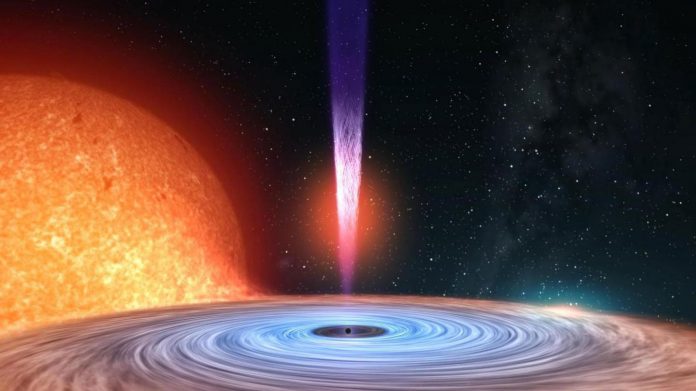A “monster” black hole gradually eating a helpless star millions of light years from Earth has been tracked by scientists.
An international team of researchers tracked the cosmic clash using powerful radio and infrared telescopes honed on the centre of two colliding galaxies; known collectively as Arp 299 and close to 150 million light years from Earth.
Over the course of 10 years, scientists watched the dramatic galactic collision unfurl with the help of the National Science Foundation’s Very Long Baseline Array (VLBA), the Spitzer Space Telescope, and other observation stations. They picked up a particularly violent event at the heart of one of the galaxies, when a star with more than twice the sun’s mass was shredded by a supermassive black hole more than 20 million times bigger than the sun.
When a star gets too close to a black hole’s event horizon, it is pulled apart by the extreme gravity and slurped into the hole as a bright flare. This is known as a tidal disruption event and, although it is hypothesised to be a regular occurrence throughout the galaxy, little is known about what happens during these stellar deaths. Astronomers argue that the destroyed star forms a rotating disk around the black hole, and that material is also launched from two poles of the hole as high-speed jets.
“Never before have we been able to directly observe the formation and evolution of a jet from one of these events,” said Miguel Perez-Torres, of the Astrophysical Institute of Andalusia in Granada, Spain.
According to the study, published in Science, at its zenith, the flare outshone the centre of its parent galaxy in the infrared and radio region. There was little visible light, which the researchers argue is down to the surrounding dust absorbing visible light and re-radiating it as infrared light. Nevertheless, telescopes on Earth honed on the galactic clash picked up the resulting radio waves, and modeled the data to glean what happened.
“Much of the time […] supermassive black holes are not actively devouring anything, so they are in a quiet state,” Perez-Torres said. “Tidal disruption events can provide us with a unique opportunity to advance our understanding of the formation and evolution of jets in the vicinities of these powerful objects.”
Seppo Mattila, of the University of Turku in Finland, said that this particular tidal disruption event may only be “the tip of the iceberg” of what is happening in the distant universe. “By looking for these events with infrared and radio telescopes, we may be able to discover many more, and learn from them.”
The activity around the supermassive black hole came as a surprise to the scientists, who were originally looking for supernova explosions. Instead, they observed for the first time a jet being produced by a tidal disruption event – a model that could help us understand what to look for when searching for black holes in the far reaches of space.















